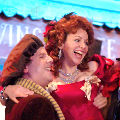

One of these tiny troupes, Amato Opera, was a veritable institution, achieving almost legendary status. Run by Anthony Amato and his wife Sally, Amato Opera opened in 1948 and lasted over 60 years, closing its doors just last spring. Its last permanent home had been on the Bowery since the early ‘60s. During its long life Amato Opera presented about 60 operas, ranging from the beloved staples of the repertoire to the truly obscure rarities.
I couldn’t believe my ears when, back in the middle ‘90s, I heard that Amato Opera was going to produce a work I had ardently longed to hear, Gomes’ Fosca. Mrs. Amato was so kind as to give me a copy of the score as a gift. After her death in 2000, Mr. Amato managed the company by himself until a few months ago, when, at the venerable age of 89, he announced the company’s closing.
However, Amato Opera is not completely dead and gone. Not one, but two opera companies claim to have their roots in it and hope to be its true offspring. Yesterday I explored one of them, Amore Opera; next Sunday it will be Bleecker Street Opera’s turn.
A group of singers, instrumentalists, staff and board members of Amato Opera has formed the new company, Amore Opera. Mr. Amato, who has bestowed his blessing upon the new company by donating sets and costumes to it, will be honored in a special Gala concert with orchestra on Valentine Day of 2010. In its press releases Amore Opera explicitly declares itself as Amato’s successor.
The company performs in the Connelly Center Theater, a charming 99-seat opera house with a horseshoe-shaped balcony, located in the East Village.
The opera chosen for the inauguration is Puccini’s La Bohème, with 12 performances scheduled until Sunday, January 3. I attended the second performance of La Bohème.
A mini-melodrama unfolded right at the beginning, as the President of the company, Nathan Hull, announced that conductor Richard Owen had been involved in a small car accident while on his way to the theater. Assistant conductor Raymond Calderone was stuck somewhere in the Bronx, and therefore clarinetist Simeon Loring would conduct the first act. Mr. Owen was eventually able to arrive in time to lead the rest of the opera.
The very traditional production featured minimal but functional and tasteful painted sets. As for the costumes, it seemed that the entire budget was lavished on Musetta’s truly elaborate second act getup.
The cast was a mixed bag. In such small opera companies, there is always an amalgam of artists with different backgrounds, from the young rising singers at their very first experiences to the good amateurs who have day jobs. All of them, no matter what their vocal capabilities, communicated their passion and joy of being on stage. Tenor Mark Filipasic (Rodolfo), baritones Gregg Kegg and Alan Gorden Smulen (Marcello and Schaunard) and bass Brinson Keeley were all effective in their roles.
It is nonetheless undeniable that the two ladies were one or two steps above the rest. Victoria Wefer brought a fittingly incisive and piercing voice, as well the appropriate verve to the role of Musetta.
But the real standout was Sabrina Palladino (Mimì), with a strong, rich, pliable instrument and crisp, idiomatic diction. Her Mimì was less sugary and more determined than most, reserving all the tension and emotions for her powerful death scene. Although it is not easy to judge the size of a voice in a 99-seat venue, I had the distinct impression that her Mimì would definitely not be out of place in a much larger company.
It is similarly arduous to evaluate a conductor’s performance when playing Bohème with a reduced orchestra of 15 instruments.
In one respect, though, the diminutive proportions of the place proved to be an asset. All things considered, it was the precisely the miniature size of the theater, more than the skills of each individual artist, that ultimately generated a particular atmosphere of intimacy, a special rapport with what was happening on stage. And I was not alone. At the very end of the opera, there wasn’t a single dry eye around me. Even the keyboard player was crying her eyes out. That, I guess, is the magic of opera.
The season of Amore Opera continues with main stage productions of The Merry Widow and The Magic Flute and “Family Briefs” of Hansel and Gretel, The Mikado and H.M.S. Pinafore. [Photo: David Wentworth Photography]

























Comments